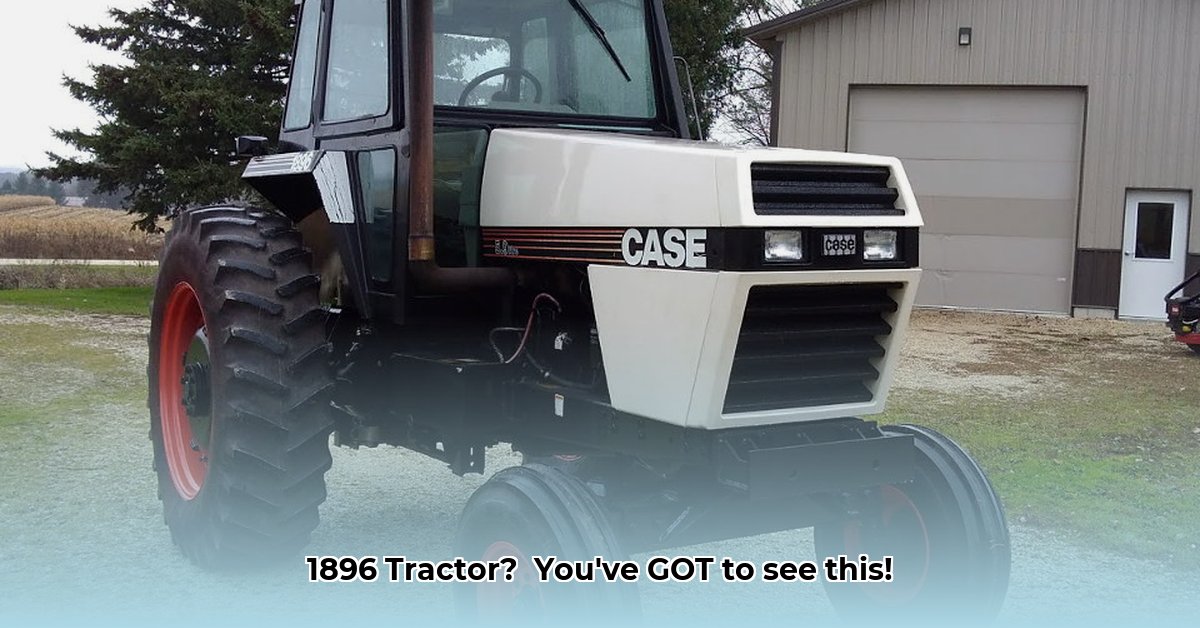
Case 1896 Tractor: A Comprehensive Buyer's Guide
Considering purchasing a Case IH 1896 tractor? This guide provides a comprehensive overview, assisting both experienced farmers and novice enthusiasts in making an informed decision. We'll explore its history, technical specifications, market analysis, buying process, maintenance, and potential problems, equipping you to confidently navigate the purchase and ownership of this iconic machine. For more information on Case IH tractors, check out this helpful resource: Case IH Tractor Info.
A Blast from the Past: Understanding the Case 1896's Legacy
The Case IH 1896, produced between 1985 and 1989, represents a significant chapter in agricultural history. Its advertised 95 PTO horsepower (70.8 kW) was impressive for its time, making it a reliable workhorse on farms nationwide. Note that Case’s transition to Case IH during these years means some tractors feature white paint while others are red; authenticating this detail is essential for accurate valuation. Did you know its robust design and powerful engine contributed to its enduring popularity?
Key Specifications: A Detailed Look Under the Hood
Before purchasing, familiarize yourself with the 1896's vital statistics. This allows for informed comparisons and ensures you're making a sound investment.
| Specification | Value | Important Notes |
|---|---|---|
| PTO Horsepower | 95 hp (70.8 kW) | Advertised horsepower; actual drawbar horsepower is typically slightly lower. |
| Drawbar Horsepower | Approximately 84.51 hp (63.0 kW) | Actual pulling power. |
| Wheelbase | 108 inches | Influences turning radius and stability. |
| Weight | 13,495 lbs | Affects ground pressure and towing capacity. |
| Hydraulic Pressure | 2250 psi | Crucial for operating attachments and maintaining hydraulic system health. |
| Fuel Capacity | Varies by model | Consult model-specific documentation for precise figures. |
| Transmission Type | Varies by model | Refer to model-specific documentation for details. |
Remember, these values are general; always consult the specific tractor's documentation for precise details. A knowledgeable mechanic can also help identify these crucial aspects.
Market Analysis: Pricing and Influencing Factors
The price of a used Case 1896 varies considerably, ranging from approximately $22,000 to over $37,500 depending on several key factors:
- Condition: A well-maintained tractor in excellent condition commands a higher price.
- Hours of Use: Lower hours usually equate to higher resale value.
- Included Implements: Additional attachments, such as a front loader, significantly impact value.
- Collector Demand: The 1896's collector appeal influences pricing trends.
A tractor with low hours, a clean history, and complete accessories will inherently command higher prices. Is it a smart investment for you given these variables?
Your Step-by-Step Guide to Purchasing a Case 1896
Buying a vintage tractor is an exciting endeavor, but careful planning is essential. These steps help ensure a smooth and successful purchase:
Thorough Inspection: A meticulous examination is paramount. Carefully check the engine, transmission, hydraulics, and the overall structure for any signs of wear, rust, or leaks. Don't rush this critical process.
Verify Paperwork: Obtain and review all maintenance records. A comprehensive history indicates responsible previous ownership.
Test Drive (When Possible): Operate the tractor under varying conditions. Listen for any unusual noises or vibrations that could signal potential problems.
Price Negotiation: Armed with your inspection findings and market research, negotiate the price confidently. Don't hesitate to walk away if the price is excessive.
Seek Professional Advice: If you lack mechanical expertise, consider hiring a qualified mechanic for a pre-purchase inspection. This proactive step can prevent costly future repairs.
Potential Problems and Maintenance Strategies
While robust, the Case 1896, like any vintage machinery, has potential issues. Common trouble areas include the engine, transmission, and hydraulic system. Regular maintenance is crucial. Building a strong relationship with a mechanic specializing in vintage Case IH equipment is advisable; finding replacement parts can be challenging and costly. What are your plans to address maintenance?
Is a Case 1896 the Right Tractor for You?
Owning a Case 1896 can be highly rewarding. Its strength, dependability, and historical significance make it an attractive option. However, it's a significant commitment. Carefully evaluate your budget, needs, and mechanical aptitude before making a decision. This decision involves not only the initial purchase but also the ongoing costs of maintenance and repair.
Pros: Powerful engine, robust construction, historical significance, relatively easier maintenance compared to some vintage models.
Cons: Age-related issues, potential difficulties in sourcing parts, and potentially high maintenance costs.
Estimating Repair Costs: A Realistic Approach
Restoring a Case 1896 is a substantial undertaking. Costs are highly variable and depend on the condition of the tractor and the extent of the restoration. It's often suggested to multiply the purchase price by ten for a rough estimate; however, this is only a starting point. Specific parts, like engines and tires, can dramatically increase costs. In what situations would this estimation be reliable?
Key Factors Influencing Repair Costs
- Initial Condition: A well-maintained tractor requires less work.
- Restoration Scope: A full restoration is far more expensive than basic repairs.
- Parts Availability: Sourcing original or reproduction parts can significantly affect cost.
- Labor Costs: Professional labor adds to the total expense.
Estimating Your Costs: A Practical Framework
- Comprehensive Assessment: Meticulously examine the tractor, noting every component's condition.
- Detailed Parts List: Create a list of every needed part, along with associated costs.
- Labor Estimation: Include labor costs, either your own time or professional rates.
- Contingency Planning: Add a contingency for unforeseen repairs (20% is a prudent starting point).
- Total Cost Calculation: Sum up all anticipated expenses, including specialized services.
Remember, restoration is a long-term project. Careful budgeting and realistic expectations are crucial for a successful outcome. What strategies will you use to manage these costs effectively?